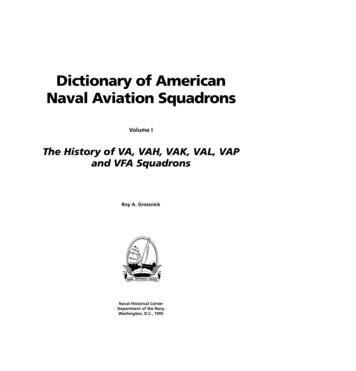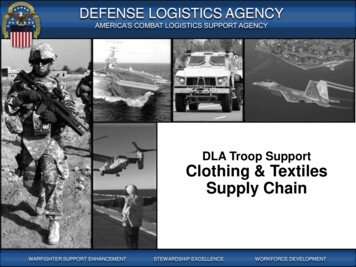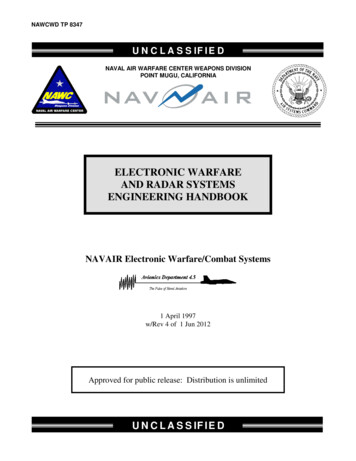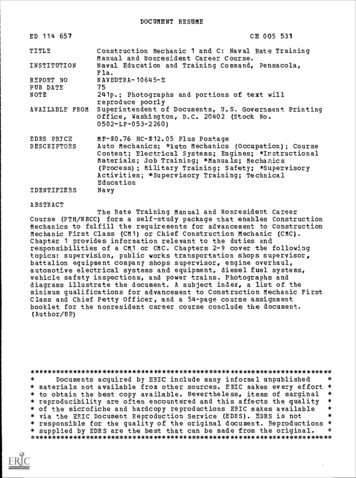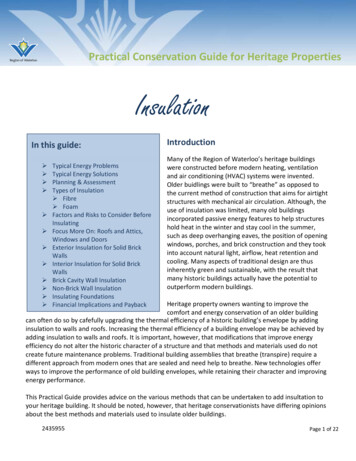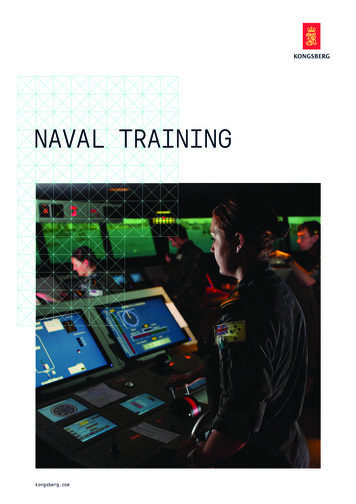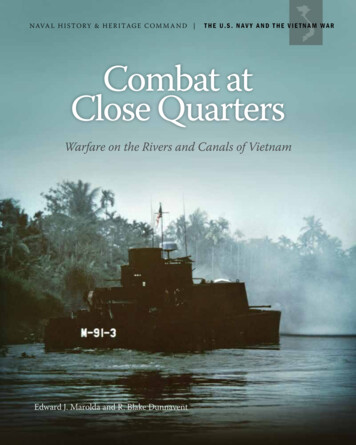
Transcription
N AVA L H I S T O R Y & H E R I TAG E C O M M A N D THE U.S. N AV Y AND THE VIE TN AM WARCombat atClose QuartersWarfare on the Rivers and Canals of VietnamEdward J. Marolda and R. Blake Dunnavent
TH E U.S. NAV Y A N D T H E V I ET N A M W A REdward J. Marolda and Sandra J. Doyle, Series EditorsCombat atClose QuartersWarfare on the Rivers and Canals of VietnamEdward J. Marolda and R. Blake DunnaventD E PA R T M E N T O F T H E N AV YWA S H I N G T O N , D C2 015
2015 Naval Historical FoundationAll rights reserved.No portion of this book may be reprinted without written permission from the Naval Historical Foundation.Printed in the United States of America.Published byNaval History & Heritage Commandin partnership with the Naval Historical Foundation805 Kidder Breese Street SEWashington Navy Yard, DC 20374-5060www.history.navy.milBook design by Dean Gardei and Christopher DunhamU.S. GOVERNMENT OFFICIAL EDITION NOTICEUse of ISBNThis is the official U.S. Government edition of this publication and is herein identified to certifyits authenticity. Use of 978-0-945274-73-5 is for the U.S. Government Publishing Office Edition only.The Superintendent of Documents of the U.S. Government Publishing Office requests that anyreprinted edition clearly be labeled as a copy of the authentic work with a new ISBN.Library of Congress Cataloging-in-Publication DataMarolda, Edward J.Combat at close quarters : warfare on the rivers and canals of Vietnam / Edward J. Marolda and R. Blake Dunnavent.pages cm. -- (The U.S. Navy and the Vietnam War)ISBN 978-0-945274-73-5 (alk. paper) -- ISBN 978-0-945274-74-21. Vietnam War, 1961-1975--Riverine operations, American. 2. United States. Naval Forces, Vietnam. River Patrol Force-History. 3. United States. Navy. Task Force 116--History. 4. United States. Mobile Riverine Force--History. 5. Vietnam War,1961-1975--Naval operations, American. I. Dunnavent, R. Blake, 1968- II. Naval History & Heritage Command (U.S.) III. Title.IV. Title: Warfare on the rivers and canals of Vietnam.DS558.7.M364 2014959.704’345--dc232014049884 The paper used in this publication meets the requirements for permanence as established by the American National Standard forInformation Sciences “Permanence of Paper for Printed Library Materials” (ANSI Z39.48-1984).For sale by the Superintendent of Documents, U.S. Government Publishing OfficeInternet: bookstore.gpo.gov; Phone: toll free 866-512-1800; DC area 202-512-1800; Fax 202-512-2104Mail Stop: IDCC, Washington, DC 20402-0001
CONTENTSIntroduction1The First Indochina War5The Vietnam Navy River Force andAmerican Advisors9The U.S. Navy and the Rivers of Vietnam17SEALORDS45The End of the Line for U.S. andVietnamese River Forces73SidebarsThe PBR22Riverine Warfare Training28Battle Fleet of the Mekong Delta32High Drama in the Delta41Vice Admiral Elmo R. Zumwalt Jr.46Black Ponies56The Swift Boat60Warriors with Green Faces64The Authors80Acknowledgments80Suggested Reading81
NHHC K-58267The meaning of brown water warfare is clear from this image of river patrol boats tied up at the Binh Thuy base inSeptember 1968.
INTRODUCTIONThroughout Vietnam’s history, inlandwaterways have been central to thecountry’s growth and development.They are where the population settledand cultivated and marketed their agriculturalproducts. The fertile Red River valley in the north,the lush Mekong Delta in the south, and the manycanals and rivers crossing those two prime growingareas brought economic prosperity and socialcohesion. During the 1960s, the Mekong Delta washome to six million people—nearly 40 percent ofSouth Vietnam’s population. The well-irrigatedpaddies that covered the flat land produced mostof the country’s rice, and the delta’s 3,000 nauticalmiles of waterways enabled farmers to bring theirharvests to market.These same water courses have figured prominently in the military history of the Vietnamesepeople. When Chinese forces invaded and occupiednorthern Vietnam over the centuries, they exploitedthe fertility of the northern delta to feed bothChinese and Vietnamese populations. Harsh treatment of the Vietnamese people by the Yuan Dynastyunder the Mongol Kublai Khan sparked an uprisingin the 13th century, during which the legendarymilitary leader Tran Hung Dao repeatedly defeatedMongol forces on the Red River and became anational hero.In the 19th century, France took advantage ofinternal strife in Vietnam to occupy the countryand establish an overseas colony that endured to themiddle of the 20th century. Like the Chinese beforethem, the French recognized the importance of therivers and canals in securing control of the countryand exploiting its resources, especially rice production. Numerous battles between French naval forcesand Vietnamese independence fighters occurredalong and on inland waters.Japan occupied Indochina in World War II withthe collusion of the Vichy French government thatcollaborated with the Axis powers. Determinedto reestablish its Asian colony after Japan’s defeatin August 1945, the “Free French” government ofGeneral Charles de Gaulle used Vietnam’s riversand canals to push troops far inland. By the end of1946, French military forces were in firm control ofthe Red River and Mekong River deltas as well as thecountry’s main navigable arteries.The First Indochina War broke out when HoChi Minh’s Viet Minh independence movement,which consisted of communist and noncommunistnationalists, rose up in revolt. Ho’s troops destroyedFrench forces on the frontier with China andsecured the jungles and mountains of northernVietnam’s interior during the early 1950s. The VietMinh, however, were unable to break French powerin the two delta regions. The French used the inlandwaterways as barriers to Viet Minh advances and ashighways to quickly move ground and naval forcesfrom one threatened area to another.French units of heavily armed and armoredriver craft, most of them surplus World War II U.S.amphibious craft, prevented Viet Minh forces fromseizing Vietnam’s primary food-producing regions,population centers, and ports. But in May 1954, theViet Minh defeated more than 10,000 French Uniontroops at Dien Bien Phu, an outpost located deepin the mountains and jungles of northern Vietnamand far from the country’s inland waterways. Therout of the French army’s most elite forces at DienBien Phu led ultimately to France’s withdrawalfrom Indochina, leaving the Democratic Republic ofVietnam (North Vietnam) under Ho Chi Minh incontrol of the northern regions of the country. TheGeneva Conference of 1954, convened by the worldpowers to bring peace to Indochina, establishedthe division between North Vietnam and SouthVietnam at the 17th parallel.The survival and future growth of the fledglinggovernment of the Republic of Vietnam (SouthVietnam) depended heavily on its ability to securethe nation’s waterways, especially the Mekong Delta1
Political chaos in Saigon, the deterioratingsecurity in the countryside in 1963 and 1964, andthe North Vietnamese attack on destroyer Maddox(DD-731) in the Gulf of Tonkin in August 1964prompted major U.S. military intervention into SouthVietnam in 1965. To stem the infiltration of weapons,ammunition, and other war materials into SouthVietnam by sea, Commander U.S. Military AssistanceCommand, Vietnam (MACV) established the CoastalSurveillance Force (Task Force 115) under ChiefNaval Advisory Group (later subordinated to a neworganization, Naval Forces, Vietnam [NAVFORV])on 30 April 1965. The United States also deployedU.S. Navy and U.S. Coast Guard destroyer escorts,ocean minesweepers, cutters, coastal craft, and patrolplanes along the country’s 1,200-mile coastline. Theeventual success of this anti-infiltration operation,NHHC K31134and the rivers that allowed access to the sea from thecapital, Saigon. From 1955 to 1965 South Vietnam,with U.S. military assistance, developed a RiverForce to protect river transportation and commercefrom attacks by indigenous Communists, the VietCong (VC).In 1959, North Vietnam decided on armed struggle to destroy the government of South Vietnamand gradually stepped up attacks on Americanmilitary advisors. In January 1960, the femaleCommunist leader Nguyen Thi Dinh sparked thefirst serious uprising against the South Vietnamesegovernment. Her insurgents stormed a number ofmunicipal buildings at Ben Tre, the capital of KienHoa Province in the Mekong Delta, and assassinated43 public officials. The stunning action served toinspire Communist guerrillas throughout the war.2A river patrol boat (PBR) speeds along a South Vietnamese river.
called Market Time, forced North Vietnam to transport munitions via inland routes through Laos andvia merchant ships into the port of Sihanoukville insupposedly neutral Cambodia.As war materials flowed into the Mekong Deltafrom Cambodia, the U.S. command on 18 December1965 stood up the River Patrol Force (Task Force116). In Operation Game Warden, 31-foot riverpatrol boats (PBRs) assisted by armed helicopterslimited the enemy’s use of South Vietnam’s largerrivers. The U.S. Navy then teamed with the U.S.Army to form the Mobile Riverine Force (MRF),whose purpose was to locate, surround, and destroymain force Communist combat units in the delta.Although these efforts hurt the enemy, suppliesfrom North Vietnam continued to get through toViet Cong and North Vietnamese forces, enablingthem to hold their own in battle with allied units.The Communists simply switched the infiltrationroutes from the main rivers to the lesser rivers,canals, and swamps of the delta. The buildup ofenemy forces culminating in the nationwide TetOffensive of 1968 severely tested the staying powerof the allied forces. In the end, however, the RiverPatrol Force, the Army-Navy Mobile Riverine Force,and the Vietnam Navy (VNN) River Force reestablished control of the delta.Hoping to cap this victory and prevent enemyforces from rebuilding their strength in the region,Vice Admiral Elmo R. Zumwalt Jr., CommanderNaval Forces, Vietnam, and his staff devisedSEALORDS (Southeast Asia Lake, Ocean, River,Delta Strategy). This strategy generated fierce battlesand high casualties on both sides, but by 1970 alliedforces had made it especially difficult for the enemyto maintain the supply route and had established amilitary presence in previously uncontested areas.U.S. Air Force, U.S. Army, and Vietnam Air Forceresources, in addition to the Navy’s OV-10 Broncofixed-wing aircraft of Light Attack Squadron (VAL)4, known as the Black Ponies, operating fromBinh Thuy in the center of the delta, significantlyboosted the combat power of the SEALORDSforces. The increase in security in the delta after1968 enabled the South Vietnamese command todivert significant combat forces for the invasion ofCambodia in 1970 and to counter the CommunistEaster Offensive north of Saigon in 1972.The SEALORDS effort equipped, trained, andprepared the Vietnam Navy to take on the fightas U.S. forces began withdrawing from Vietnamin the early 1970s. Accelerated Turnover to theVietnamese (ACTOV) was the naval component ofthe overall U.S. Vietnamization program. By theend of March 1973, when the last American militaryunits departed South Vietnam, the VNN operated1,500 naval vessels that included hundreds offormer U.S. river patrol boats, Swift boats, riverineassault craft, minesweeping craft, and river logisticsupport bases. South Vietnam’s defeat in 1975 didnot result from the failure of the VNN or the loss ofcontrol over the nation’s waterways; the Republic ofVietnam succumbed to a massive North Vietnameseground offensive that advanced inexorably fromthe hills of central and northern South Vietnam toengulf Saigon.The fight in the Mekong Delta during thelosing struggle for South Vietnam took place halfa century ago. But the service and sacrifice of U.S.Sailors demonstrated America’s commitment to itsSouth Vietnamese allies in defense of freedom anduniversal human rights. Moreover, the conduct of theriver war in Vietnam helped inform naval operationsin more recent conflicts. Looking to the past forguidance, the U.S. Navy established three riverinesquadrons that operated successfully on the inlandwaterways of Iraq during Operation Iraqi Freedom. 3
NH 79376French patrol boat sailors scan the riverbank for signs of Viet Minh guerrillas.
THE FIRST INDOCHINA WARNHHC VN CollectionFrench involvement in Southeast Asia datedfrom the late 18th century when NguyenPhuc Anh of the Nguyen Dynasty—laterknown as Emperor Gia Long—requestedFrench assistance in defeating his enemies anduniting the Vietnamese. The French, however,continually expanded their imperial control over aweak succession of Vietnamese emperors so that bythe 20th century France dominated Vietnam’s threemain regions: Tonkin in the north, Annam in thecenter, and Cochinchina in the south. Following thebrief interlude of Japanese occupation during WorldWar II, the French reestablished their colonial presence in Vietnam, Laos, and Cambodia, triggeringthe First Indochina War.The French military command planned toconduct the campaign in three stages: gain controlof and establish bases on the country’s main roadsand waterways (where, the French believed, the VietMinh forces extensively moved fighters and munitions); establish strong points to deny the enemyaccess to resources and the population; and inspireand arm Vietnamese villagers to oppose Ho ChiMinh’s guerrilla army. The success of this strategydepended on control of the Tonkin and Mekongdeltas and the coastal regions.Vice Admiral Paul Philippe Ortoli, commanderof French naval forces in the Far East, directed hiscommand to focus on “clearing and controlling thenetwork of interior waterways which serve as theprincipal means of access to the life of the country.”Following the Far East Naval Brigade’s successful1945 operations to oust the Viet Minh from CanTho and My Tho in the Mekong Delta, GeneralJacques-Philippe Leclerc, commander of all Frenchmilitary forces in the Far East, directed CaptainFrancois Jaubert to organize a river squadron, orflotilla, of landing craft and naval infantry to securethe Mekong and Bassac rivers.This initial riverine force evolved into thedivision navales d’assaut (dinassauts, or navalVice Admiral Paul Philippe Ortoli, commander of Frenchnaval forces in the Far East, poses in front of a map ofIndochina.assault divisions). Dinassauts typically included12 converted U.S. World War II landing craftmechanized (LCM); landing craft utility (LCU);landing craft tank (LCT); landing support ship,large (LSSL); landing craft, vehicle or personnel(LCVP); landing craft, infantry (LCI); and landingship infantry, large (LSIL). French-built river patrolcraft, referred to as STCAN/FOMs, augmentedthese units. In addition to infantry small arms, eachvessel maintained an array of larger ordnance suchas 81mm mortars, 20mm cannon, 40mm cannon,37mm cannon, 3-inch guns, .50-caliber machine5
YUNNAN PROVINCEayRiCle ar RiverChReveCao BangVIET BACCHINADong KherdK WA N G S I P R O V I N C ERiverTuyen QuangPhuYenBinhT ’A IHIGHLANDSLang SonPhu DoanBl ack RiveTONKINNgoc ThapNghia LoViet TrirVinh YenTrung HaDa Bach RiverHanoiLang Tu VuMao KheHaiphongHoa BinhDay RiverPhu Nho QuanLAOSMon CayPhu ThoPhu LyNamDinhNinh BinhYen Cu HaGULF of TONKINRed River Delta.6guns, and .30-caliber machine guns. A total of sixdinassauts eventually served in Indochina. Theirmission was to insert and extract troops and toprovide emergency evacuation of isolated outpostsalong the rivers.By most accounts, French military and navalforces swiftly subdued Viet Minh guerrilla units inCochinchina, thus permitting the pacification ofsouthern Vietnam. The dinassauts, however, servedprimarily in the Red River Delta, with each groupoperating from a base defended by either navalcommandos or army infantry. They conducted riverpatrols or teamed with ground troops to subdueenemy forces. Close coordination between navaland ground troops was essential because dinassautslacked their own assigned ground force. In a typicalriverine amphibious assault, lead elements checkedthe approach waters for mines, gunfire units shelledthe prospective landing site to kill or disorientdefenders, and the assault infantry disembarked andsecured a riverbank position. Then the main infantry force landed and moved out into the terrain.Simultaneously, the naval craft set up flanking positions on either side of the landing site and stood byto provide gunfire support. If the battle ashore wentbadly for the French, the naval vessels were on handto extricate the ground troops. Air force units oftenprovided aerial reconnaissance of the immediatearea to warn of enemy concentrations and preventambushes.The battles on the Day River amply demonstrated the flexibility and lethality of French riverforces. To gain control of the strategic Red RiverDelta, General Vo Nguyen Giap, military commander of the Viet Minh forces, launched a seriesof attacks in early 1951. Twice, French forces led byGeneral Jean de Lattre de Tassigny repulsed Giap’sattacks and inflicted heavy casualties on the VietMinh infantry at Vinh Yen and Mao Khe. On 28May 1951, Giap’s forces hit French positions near
Ninh Binh on the Day River. General de Lattredirected army and naval forces to this locale. Aftersuccessfully thwarting a Viet Minh ambush northof Ninh Binh, Dinassaut 3 brought reinforcements and added firepower against Giap’s forces.De Lattre counterattacked on 30 May with bothground and riverine units. Although Giap’s failedcampaign lasted until 18 June, the climax of thebattle occurred on 5 June at Yen Cu Ha where theFrench riverine vessels pummeled Viet Minh unitswith gunfire, forcing them to withdraw from thebattle. The swift provision of riverine forces, groundreinforcements, and naval gunfire enabled de Lattreto engineer the victory.Despite dinassaut successes in open combat,waterborne mines plagued French riverine operations throughout the conflict. Although the Frenchswept rivers prior to naval operations to help limitcasualties, the enemy often employed new andingenious tactics to confound French minesweepingmeasures. For all their thoroughness, French minesweeping units could never be assured that mineswould not frustrate a naval operation.Despite the effectiveness of the riverine forces,France lost the First Indochina War. The Viet Minhtrapped the cream of the French Union forces (onetenth of France’s military strength in Vietnam)at Dien Bien Phu, an airfield and outpost deep inthe jungles of northern Vietnam and far from thedelta waterways. On 7 May 1954, Giap’s forcesoverwhelmed the last French defenders. At aninternational conference in Geneva, Switzerland,France agreed to a cease-fire and the withdrawalof its forces from Indochina. The agreement alsoprovided for the partition of Vietnam at the 17thparallel with Ho Chi Minh’s Democratic Republic ofVietnam ruling the regions to the north. Eventually,a Republic of Vietnam government headed byanticommunist Ngo Dinh Diem administeredCochinchina and the southern half of Annam. 7
NHHC VN CollectionNgo Dinh Diem, President of the Republic of Vietnam, inspects a warship of the Vietnam Navy (VNN) in the mid-1950s.The uniforms of these sailors reflect the French influence on the new naval service. South Vietnam’s navy would latertake on the look of the U.S. Navy, which became its primary benefactor.8
THE VIETNAM NAV Y RIVER FORCE AND AMERICAN ADVISORSNA 80-G-K-22608In keeping with Washington’s global Coldand other Southeast Asian nations. To prevent suchWar policy of “containment” that aimed toan outcome, in September 1954 the United Statesprevent the spread of Communist power andjoined with Great Britain, Australia, and otherMarxist-Leninist ideology, the United Statesconcerned nations to form the Southeast Asia Treatyprovided economic and military support to FranceOrganization (SEATO). The Geneva Agreement ofduring the First Indochina War. In the Mutual1954 prohibited Cambodia, Laos, and what becameDefense Assistance Program, from 1950 to 1954,the Republic of Vietnam from joining SEATO, butFrance received military aid totaling 2.6 billionthe organization in essence existed to protect thosefrom the United States. This assistance includednations from North Vietnam and China.two light aircraft carriers; 438 amphibious landingWith France’s withdrawal from Indochina, theships, landing craft, and armored river patrol boats;United States took over responsibility for equippingand 500 aircraft.and training the armed forces of the Republic ofThe Vietnam Navy of the Republic of VietnamVietnam. The Navy Section of the U.S. Militaryserved President Diem’s fledglinggovernment well in 1955 by employingthe river, coastal, and amphibiousvessels handed over to them beforethe French withdrew from southernVietnam. In late March 1955, the BinhXuyen, an armed 25,000-man groupthat supported itself through criminalenterprises in Saigon, posed a directthreat to Diem’s new government.After driving Binh Xuyen fighters outof Saigon, Diem employed VNN riverforces to defeat a group of hold-outs inthe swamps of the Rung Sat (“Forest ofAssassins”) southeast of the capital. Byyear’s end the VNN had eradicated theBinh Xuyen’s military power. It wasthe first major test for the new navy,and the young service’s success in theeffort impressed Diem.The administration of U.S.President Dwight D. Eisenhowerwas especially concerned afterFrance’s defeat at Dien Bien Phu thatCommunist movements would followPresident Dwight D. Eisenhower, shown here with Chief of Navalup the conquest of northern VietnamOperations Admiral Arleigh Burke, championed establishment of theby seizing southern Vietnam, Laos,Southeast Asia Treaty Organization to combat Communist aggression inCambodia, the Philippines, Indonesia,the region.9
DMZDongHaCua VietQuang TriHueDanangTHAILANDLAOSHoi AnDung Quat BayChu LaiQuang NgaiKontumPleikuCENTRALHIGHLANDSQui NhonTuy HoaCAMBODIASOUTHVIETNAMMekong RiverCape KegaVung RoBen Goi BayNha TrangDalatPhnom PenhCam RanhBayPhuoc VinhTay NinhBien HoaCaoLanhPhuQuocIslandDuongDongAn ThoiGULF ofSIAMSaigonPlain of ReedsMEKONGD E LTAMy ThoBinh GiaPhan ThietCat LoVung TauCan ThoSOUTH CHINA SEAU MinhSon IslandNHHCCape Ca MauSouth Vietnam.10
Tho, and Long Xuyen, the latter all in the MekongDelta. The units alternated between one month ofoperations and one month of training.Each RAG operated 17 to 19 modified WorldWar II U.S. landing craft. An LCM-6 commandament (the Vietnamese continued to use the Frenchspelling to identify this boat) served as a commandship and provided communications and gunfiresupport. Each of the groups also contained onemonitor, similar to the commandament but able toproject more firepower. The monitors carried one40mm cannon, two 20mm cannons, one .50-calibermachine gun, and an 81mm mortar. The RAG’s fiveLCMs, 12 LCVPs, and the French-designed STCAN/FOMs transported troops and supplies.A typical river operation in the delta includedsix LCMs, four LCVPs, two small patrol boats,and several marine ground units (there were fourVietnam Marine Corps battalions directed by theNH 93793Assistance Advisory Group (MAAG), Vietnamhandled naval matters.In 1956, U.S. Navy advisors received ordersfrom Admiral Felix B. Stump, Commander in Chief,Pacific (CINCPAC), to help the VNN secure theinland waterways of South Vietnam and support theother Vietnamese armed forces. To accomplish thesemissions, the VNN would conduct river and coastalpatrols to interdict enemy waterborne movement aswell as minesweeping to keep the country’s waterways open to military and civilian traffic. CINCPACrecommended that the VNN conduct riverineassault operations with ground troops.The VNN created river assault groups (RAGs)based on the French dinassaut model. In 1959, theRiver Force commander, based at Can Tho, directedclose to 100 boats and craft, organized into five riverassault groups. The two-officer, 100-man RAGs weredeployed at Saigon and at My Tho, Vinh Long, CanA French-designed STCAN/FOM river patrol boat that served in a river assault group of the Vietnam Navy.11
Tay NinhngDoCo verVam RiCAMBODIATan ChauMekChauDocHa TienTri TonPlain of ReedsongRivSaigonCholonAp BacRungSaterMy ThoLongXuyenDai RiverSaDecssacRiverChieonLuBaBen TreIlo Ilo IslandmCan ThoCoHaVinh LongRach GiaBien HoaThu DucnRivegRriverDon ChauSoc TrangU MinhBac LieuVinh ChauCa MauNam CanCua Lon RiverOng TrangTan AnSOUTH CHINA SEABo De RiverSon IslandNHHCCape Ca MauMekong Delta.12VNN headquarters based in the region) conductingassaults in An Xuyen Province. Another two LCMsand two LCVPs patrolled the Cambodian bordernear Chau Doc, while one LCM and two LCVPsoperated on the Tranh Dong River in the Rung Satswamp below Saigon. At the same time, two LCVPsprotected a Vietnamese army fuel depot upriverfrom Saigon. The River Force carried out 27 jointarmy-navy operations in 1961.Even though VNN leaders resented being usedby the army as a supporting arm, the navy followedthe direction of the senior service to escort convoysladen with charcoal and rice from the delta toSaigon. Frequently, the enemy prevented these products from reaching the capital. The River Force commander allocated 18 STCAN/FOMs, 4 LCMs, and8 LCVPs to a new command, the River TransportEscort Group. During 1961 the River Forcefacilitated the delivery of over one million tons ofcargo to Saigon. On five occasions the Communistsdetonated mines in proximity to the convoys butfailed to seriously damage even one transport.Mines, however, were a particular worry forboth the army and navy. Enemy mine warfare
uninjured troops who drove off the attackers. Theshort, yet sharp fight either wounded or killed 31South Vietnamese soldiers.A July 1961 River Force operation was more successful; in fact, it was the largest and most productive army-navy action against the Communists since1954. South Vietnamese military leaders targeteda longtime VC stronghold in an area of Kien PhongProvince bounded on all sides by canals and theMekong River. From 4 to 16 July, River Force combatcraft, army artillery, and paratroopers deployed allaround the enemy concentration and poured heavyfire into the enemy positions. The paratroopers thenadvanced. Trying but failing to escape the everclosing trap, the Viet Cong stood and fought. By theend of a six-hour battle, on the morning of the 16th,the South Vietnamese forces had crushed the 502ndViet Cong Battalion and a company from the 504thBattalion, killing 167 men, capturing 11 more, andrecovering 85 weapons.Later that year, Washington decided to provideadditional resources to strengthen the River Force.This U.S. provision of river craft enabled the VNNto create the 22nd River Assault Group in SeptemberNH 93778tactics differed little from those used during theFirst Indochina War. From a hiding place on theriverbank, a Viet Cong guerrilla would use a wireconnection to a battery to trigger a mine when thelead ship in a convoy approached the narrows ofa waterway. Then other guerrillas would open fireon the stalled convoy. To cut wires between theguerrillas ashore and their mines, River Force unitsdragged grapnels behind them or strung cuttingcables between a pair of LCVPs.These countermining tactics did not work,however, during a 25 November 1960 battle in DinhTuong Province. The operation began when an armycommander, without asking for navy input, orderedthree River Force LCMs to move an infantry battalion through narrow canals into a position near thePlain of Reeds. Near dusk, a mine explosion liftedthe lead vessel out of the water, stove in her bulkheads, and caved in the roof over the well deck. Theblast threw the seated soldiers against the overhead;the muzzles of several rifles punched holes throughthe wooden planking. Viet Cong fire then rakedthe force. The LCMs opened up with their 20mmguns, beached on the riverbank, and disembarkedA South Vietnamese naval officer communicates with other leaders in the river assault group from the overhead of hiscommand-control vessel, or commandament. The tall individual below him and to his front is an American naval advisor.13
NH 43013A converted U.S. landing craft of the VNN River Force transports South Vietnamese troops on a river in the Mekong Delta.141962. Vietnamese naval leaders and their Americanadvisors conceived the new RAG as a mobile groupthat would operate from an LCU in the Saigon Riverin support of army forces. Shortly afterward, theRAG headed for the Rung Sat with a company ofmarines embarked for a 30-day operation to test thenew concept. The mobile group put small parties ofmarines dressed in civilian clothes ashore to gatherintelligence. The RAG later landed troops to engagethe enemy. The operation resulted in the killing of26 Viet Cong guerrillas and the destruction of aheadquarters, arms-making site, jungle hospital, andtraining camp. The South Vietnamese lost one sailorkilled and three wounded. A captured Communistdocument spoke to the success of the operation:“Disruption of traffic lines and shortage of foodstuffs is critical.”By the end of 1963, the River Force operated 208vessels, almost twice the force’s number in 1959. Asa result of increased VNN support and the establishment in December 1961 of the River Force School,which graduated 200 men every month thereafter,the river assault groups were fully manned by theend of 1963. The primary mission remained thesame: to support army operations in the MekongDelta. The River Force did not focus on interdictingCommunist waterway traffic in the delta.Indeed, one problem the River Force dealt withwas the practice of III Corps (Saigon region) andIV Corps (Mekong Delta) province chiefs, usuallyarmy officers, tasking the river units with staticdefense duties that reduced the number of craftavailable for offensive missions or maintenance.To solve this dilemma, in 1962 U.S. naval advisorspersuaded Washington to supply the VNN with 145LCVPs that eventually formed 20 paramilitary Ci
Combat at Close Quarters Warfare on the Rivers and Canals of Vietnam Edward J. Marolda and R. Blake Dunnavent THE U.S. NAVY AND THE VIETNAM WAR Edward J. Marolda and Sandra J. Doyle,
